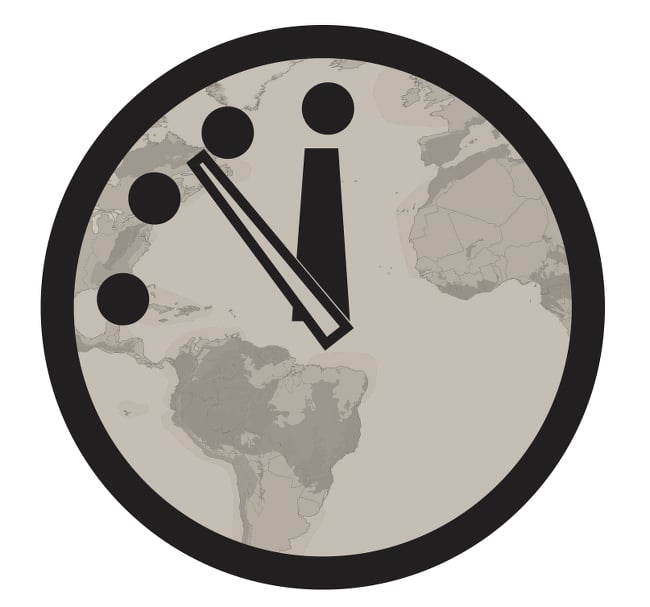
"The level of cooperation has been very low for renewable technology. "The other nuclear armed states are not willing to reduce their weapons until US and Russia reduce their warheads to under 1,000." Take action while there is still timeĪlthough the Doomsday Clock has not hit its worst time, which was two minutes to midnight in 1953 when the US government decided to pursue the hydrogen bomb, the scientists say that people must stand up and demand change, otherwise the globe will change irrevocably. "Since the end of the Cold War, there has been cautious optimism about the ability of nuclear weapon states to keep the nuclear arms race in check and to walk back slowly from the precipice of nuclear destruction," she said. North Korea expanding its nuclear weapons programme with no restrictions.Israel continuing to modernise its undeclared nuclear forces.France and China are developing nuclear ballistic weapons.UK has halved its pile of nuclear warheads, but still supports the Trident nuclear submarine programme.Squassoni also listed examples of other countries who have continued to expand and modernise their nuclear weapons programmes: "Unless much greater emissions reductions occur very soon, the countries of the world will have emitted enough carbon dioxide and other greenhouse gases by the end of this century to profoundly transform the Earth's climate." Rising nuclear tensionsĪs for nuclear weapons, Sharon Squassoni, a member of the BAS' Science and Security Board, and director and senior fellow at the Proliferation Prevention Program, Center for Strategic and International Studies, said that nuclear weapons reduction programmes in the US and Russia have "ground to a halt".įrom 2009 to 2013, the Obama administration cut only 309 warheads from the stockpile, while Russia cut only 1,000. "Efforts at reducing global emissions of heat-trapping gases have so far been entirely insufficient to prevent unacceptable climate disruption. Global emissions rates are now 50% higher than in 1990," Richard Somerville, a member of the BAS' Science and Security Board and a distinguished professor emeritus at Scripps Institution of Oceanography, University of California San Diego, said at the press conference. "The world will be between 3-8 degrees Celsius warmer by the end of the century. The BAS is a group of international scientists, which includes 18 Nobel laureates. The BAS' Science and Security Board said in a statement: "In 2015, with the Clock hand moved forward to three minutes to midnight, the board feels compelled to add, with a sense of great urgency: 'The probability of global catastrophe is very high, and the actions needed to reduce the risks of disaster must be taken very soon.'"

In particular, the BAS cited the continued global nuclear weapons modernisation, halting of nuclear reduction and unchecked climate change as key reasons why the clock has been moved forward. The Bulletin of the Atomic Scientists (BAS) has announced that the minute hand of the Doomsday Clock will be adjusted from five to three minutes to midnight, and that urgent action is required to prevent an imminent global catastrophe. The anniversary book chronicles the Doomsday Clock's references in novels by writers such as Stephen King and Piers Anthony, comic books ( Watchmen, StormWatch), movies ( Justice League), music (The Who, The Clash, Smashing Pumpkins) and numerous art exhibitions.The Doomsday Clock has gone forwards to three minutes to midnight - citizens of the world must demand action from their leaders to prevent a global catastrophe Reuters It has permeated not only the media landscape, but culture itself. The board will announce the time in January 2022 and commemorate the Clock's 75th anniversary with an upcoming book.Īs one of the most recognizable symbols in the past 100 years, the Doomsday Clock sits at the crossroads of science and art. The board members weigh dangers posed by climate change, nuclear risk and disruptive technologies in determining the time. The Clock, a powerful symbol for how close humanity is to self-annihilation, is set by the Bulletin's Science and Security Board once a year.

The Bulletin of the Atomic Scientists is in complete agreement with the sentiment that "we need to act now," but would like to clarify that the Doomsday Clock, which it created in 1947, is currently set at 100 seconds to midnight. "It's one minute to midnight on that doomsday clock and we need to act now."

"Humanity has long since run down the clock on climate change," Johnson said.


 0 kommentar(er)
0 kommentar(er)
